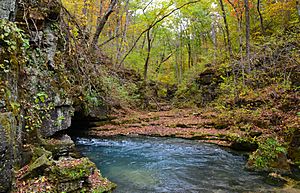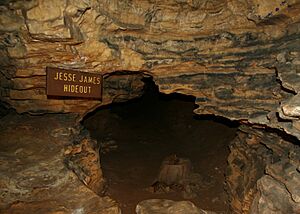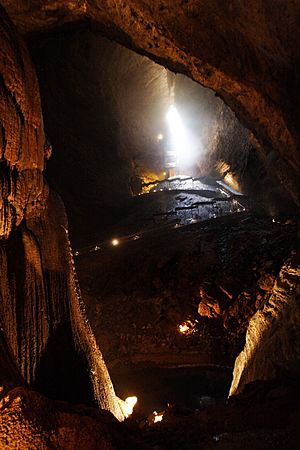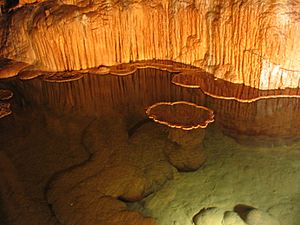List of National Natural Landmarks in Missouri facts for kids
Did you know that Missouri is home to some truly special natural places? These spots are called National Natural Landmarks. They are recognized because they have unique plants, animals, rocks, or landforms that are important to science and education.
Missouri has 16 of these amazing landmarks. Let's explore some of them!
Contents
Discovering Missouri's Natural Wonders
Missouri's National Natural Landmarks show off the state's incredible natural beauty. From ancient forests to vast prairies and mysterious caves, these places are like living museums. They help us understand how our Earth works and how different ecosystems thrive.
Ancient Forests and Prairies
Some of Missouri's landmarks protect rare and old forests or wide-open grasslands.
- Big Oak Tree State Park is a very special place. It has a rare, untouched forest with huge trees. Some of these trees are even state and national champions! This park is in East Prairie, Mississippi County. It became a landmark in 1986.
- Golden Prairie is a piece of land that has never been plowed. It's a perfect example of what a tall grass prairie used to look like. You can find it near Golden City in Barton County. It was named a landmark in 1975.
- Maple Woods Natural Area protects a nearly untouched forest. Here, you can see sugar maple and mockernut hickory trees growing as they have for a very long time. This area is in Clay County and became a landmark in 1980.
- Taberville Prairie Conservation Area is one of the biggest tall grass prairies left in its natural state. It's a great place to see what Missouri looked like centuries ago. This landmark is in St. Clair County and was recognized in 1975.
- Tucker Prairie is another virgin tall grass prairie. It sits right where the oak-hickory forests meet the typical tall grass prairies. This unique spot is in Callaway County and was named a landmark in 1975.
- Wegener Woods is an old forest mostly made up of oak and hickory trees. It's slowly changing into a forest where sugar maples are more common. This landmark is in Warren County and became a landmark in 1975.
Mysterious Caves and Springs
Missouri is famous for its caves and springs. Many of these natural wonders are protected as landmarks.
- Carroll Cave has a complex system of underground streams and smaller rivers. It's like a hidden world flowing beneath the surface. This private cave in Camden County was recognized in 1977.
- Cupola Pond is one of the oldest sinkhole ponds in the Ozark plateaus. It's located within the Mark Twain National Forest in Ripley County. This federal land became a landmark in 1974.
- Grand Gulf State Park is an amazing example of karst topography. This means the land was shaped by dissolving rock, creating caves and sinkholes. This park has a huge canyon that used to be a collapsed cave. It even has a 200-foot natural bridge! Water from this canyon travels 9 miles to emerge in Mammoth Spring, Arkansas. It's in Oregon County and became a landmark in 1971.
- Greer Spring is a powerful spring in the Ozarks. Its water flows into a beautiful, fast-moving stream. This private spring in Oregon County was named a landmark in 1980.
- Maramec Spring is the fifth largest natural spring in Missouri. It's part of a privately owned park that also has a famous trout fishing area and historic iron works. This landmark is near St. James in Phelps County and was recognized in 1971.
- Mark Twain and Cameron Caves are excellent examples of "maze" type caves. This means they have many twisting passages. These private caves in Marion County became a landmark in 1972.
- Marvel Cave is home to some of the largest and most impressive dripstone formations (like stalactites and stalagmites) found in the Ozark caves. This private cave in Stone County was recognized in 1972.
- Onondaga Cave State Park has an incredible variety of speleothems. These are all the different types of formations you find in caves, like columns, flowstones, and draperies. This state park in Crawford County became a landmark in 1980.
- Pickle Springs contains one of the best examples of a Pleistocene relict habitat in Missouri. This means it's a place where plants and animals from the Ice Age still survive today. This state park in Ste. Genevieve County was recognized in 1975.
- Tumbling Creek Cave is special because it has the most diverse group of animals found in any cave west of the Mississippi River. This private cave in Taney County was named a landmark in 1980.
These National Natural Landmarks are important for learning about our planet's history and protecting its future. They are places where you can explore and appreciate the amazing natural world around us.
Images for kids



















